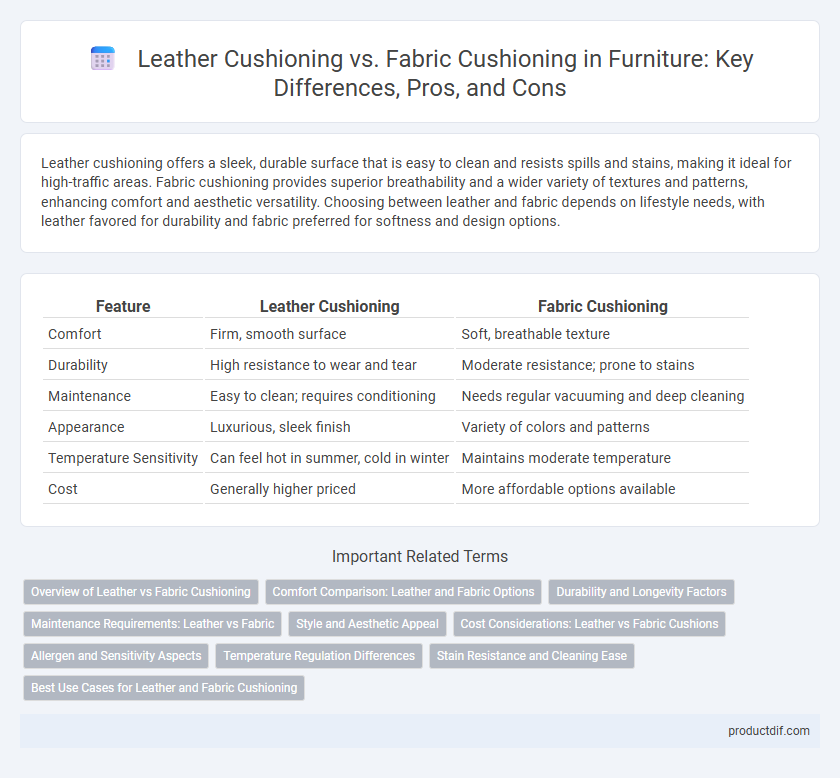Leather cushioning offers a sleek, durable surface that is easy to clean and resists spills and stains, making it ideal for high-traffic areas. Fabric cushioning provides superior breathability and a wider variety of textures and patterns, enhancing comfort and aesthetic versatility. Choosing between leather and fabric depends on lifestyle needs, with leather favored for durability and fabric preferred for softness and design options.
Table of Comparison
| Feature | Leather Cushioning | Fabric Cushioning |
|---|---|---|
| Comfort | Firm, smooth surface | Soft, breathable texture |
| Durability | High resistance to wear and tear | Moderate resistance; prone to stains |
| Maintenance | Easy to clean; requires conditioning | Needs regular vacuuming and deep cleaning |
| Appearance | Luxurious, sleek finish | Variety of colors and patterns |
| Temperature Sensitivity | Can feel hot in summer, cold in winter | Maintains moderate temperature |
| Cost | Generally higher priced | More affordable options available |
Overview of Leather vs Fabric Cushioning
Leather cushioning offers a durable, easy-to-clean surface that resists stains and provides a sleek, luxurious appearance ideal for high-traffic areas. Fabric cushioning delivers enhanced breathability, a wider range of textures and colors, and superior softness, contributing to a cozy and customizable seating experience. Choosing between leather and fabric depends on factors such as maintenance preferences, aesthetic style, and environmental comfort requirements.
Comfort Comparison: Leather and Fabric Options
Leather cushioning offers a sleek, durable surface that adapts to body temperature, providing firm yet comfortable support that improves with age. Fabric cushioning provides a softer, more breathable feel, ideal for extended sitting by preventing heat build-up and offering a variety of textures and patterns. Both materials deliver comfort tailored to preferences, with leather excelling in durability and easy maintenance, while fabric excels in warmth and breathability.
Durability and Longevity Factors
Leather cushioning offers superior durability due to its resistance to wear, stains, and moisture, making it ideal for long-term use in high-traffic areas. Fabric cushioning varies widely in durability depending on material type, with synthetic fibers like polyester and nylon providing enhanced longevity through stain resistance and tensile strength. Proper maintenance, including regular cleaning and conditioning, significantly extends the lifespan of both leather and fabric upholstered furniture.
Maintenance Requirements: Leather vs Fabric
Leather cushioning requires regular conditioning to prevent cracking and maintain suppleness, while fabric cushioning demands frequent vacuuming and spot cleaning to remove dust and stains. Leather's non-porous surface resists spills better, reducing deep cleaning frequency compared to absorbent fabric materials. Over time, fabric cushions often need professional cleaning or replacement due to wear, whereas well-maintained leather can last longer with minimal upkeep.
Style and Aesthetic Appeal
Leather cushioning offers a sleek, sophisticated look that enhances modern and classic furniture styles with its smooth texture and natural sheen. Fabric cushioning provides a wide range of colors, patterns, and textures, allowing for versatile design options that complement casual and cozy interiors. Both materials contribute distinct aesthetic appeals, with leather exuding luxury and durability, while fabric delivers warmth and personalized flair.
Cost Considerations: Leather vs Fabric Cushions
Leather cushioning typically commands a higher upfront cost due to premium material quality and durability, making it a long-term investment for furniture buyers. Fabric cushions offer a more budget-friendly option, with a wide array of textures and colors available at various price points, suitable for cost-sensitive consumers. Maintenance expenses also differ, as leather requires specialized cleaners while fabric cushions may need frequent washing or replacement over time.
Allergen and Sensitivity Aspects
Leather cushioning is hypoallergenic, resisting dust mites, pet dander, and other common allergens, making it an ideal choice for individuals with asthma or allergies. Fabric cushioning, especially natural fibers, can trap allergens and require more frequent cleaning to prevent irritation and sensitivity issues. Choosing leather over fabric can significantly reduce allergen exposure and enhance indoor air quality for sensitive users.
Temperature Regulation Differences
Leather cushioning offers superior heat resistance and tends to remain cooler in warm environments due to its natural breathability and moisture-wicking properties. Fabric cushioning, especially those with breathable weaves like cotton or linen, provides enhanced airflow and better temperature regulation in both hot and cold conditions by allowing heat and moisture to dissipate effectively. The choice between leather and fabric cushioning significantly impacts comfort levels based on room temperature and humidity, with leather excelling in temperature stability and fabric delivering versatile climate adaptability.
Stain Resistance and Cleaning Ease
Leather cushioning offers superior stain resistance due to its non-porous surface, making it easier to wipe off spills and prevent liquid absorption. Fabric cushioning, while often more breathable and soft, tends to absorb stains quickly and typically requires professional cleaning or specialized stain removers to maintain appearance. Choosing leather improves durability and simplifies maintenance, whereas fabric cushions demand more frequent and intensive cleaning efforts.
Best Use Cases for Leather and Fabric Cushioning
Leather cushioning offers durability and easy maintenance, making it ideal for high-traffic areas such as living rooms and offices where frequent use demands resilient materials. Fabric cushioning provides superior breathability and a wider range of colors and textures, perfect for cozy, low-traffic spaces like bedrooms and lounges that prioritize comfort and aesthetic variety. Choosing leather is best for households with pets or children due to its stain resistance, whereas fabric excels in environments seeking warmth and softness.
Leather cushioning vs Fabric cushioning Infographic

 productdif.com
productdif.com